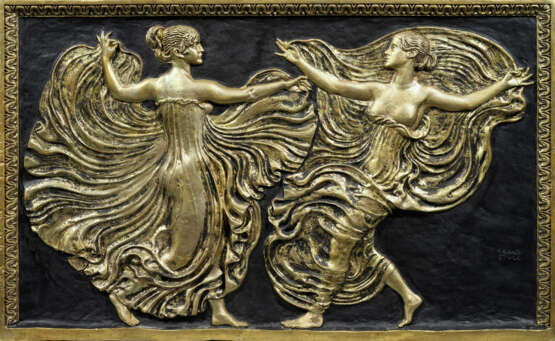ID 1278368
Lot 2602 | Franz von Stuck
Estimate value
€ 12 000 – 24 000
(1863 Tettenweis/Niederbayern - 1928 Tetschen)
"Serpentinentänzerinnen" (ursprünglich "Die Tänzerinnen"). Originaltitel
Gipsrelief, schwarz und goldfarben gefasst, 1895. R. u. im Hintergrund sign.; Das Relief entstand nach längeren Studien im Zusammenhang mit Stucks Planungen für seine eigene Villa als Gesamtkunstwerk in München. Dort verwendete er es gleich zweimal: als Gipsrelief im Musiksalon und als geringfügig größeres Bronzerelief an der Gartenmauer. Später ließ Stuck weitere Exemplare des Gipsreliefs ausführen, mit denen er auch fremde Privaträume ausstattete. Dargestellt sind zwei junge, sich gegenüberstehende Frauen, die sich in leichten, weiten Gewändern dem Tanz hingeben; während ein ornamental verzierter Rahmen das Relief auf den Seitenkanten und der oberen Kante einfasst, bleibt die untere Kante schmucklos und dient hierdurch zugleich als Standfläche der Tänzerinnen. Das Relief spiegelt sowohl Franz von Stucks Auseinandersetzung mit antiken Tanzreliefs als auch mit dem modernen, freien Tanz seiner Zeit wider. Dieser wurde seit Ende des 19. Jhs. durch die legendären Auftritte der amerikanischen Tänzerin Loïe Fuller (1862 - 1928), später auch von Isadora Duncan (1877 - 1927) propagiert. Schon seit 1892/93 machte Fuller mit ihren durch Lichteffekte eindrucksvoll verstärkten Serpentinentänze, bei denen sie in weite, weiße Schleierkostüme gehüllt war, in Paris Furore, inspirierte zahlreiche Künstler. Auch wenn Franz Stuck die Tänze der Fuller nicht im Original gesehen haben mag, so waren ihm diese sicherlich durch Berichte, Fotografien und Werke anderer Künstler bekannt. Die Tänze Fullers und Duncans entsprachen den eigenen Vorstellungen und Interessen Stucks, denn sie waren der Ausdruck dionysischer Lebensfreude im Geist der Antike, ein Rausch der Schönheit und Sinnlichkeit. Dies setzte er beim vorliegenden flachen Relief um, das die dynamische Bewegung der beiden Tänzerinnen schildert, wobei er mit ornamentaler Linienführung, Symmetrien und Asymmetrien spielte. Ca. 62 cm x 101 cm x 3,5 cm.
Weitere Exemplare befinden sich u.a. im Museum Villa Stuck in München. (Inv.-Nr. P 91 1-2) und im Museum für Kunst- und Kulturgeschichte der Stadt Dortmund (Inv.-Nr. C 6103).
Painted plaster relief, 1895. Signed.
| Artist: | Franz von Stuck (1863 - 1928) |
|---|---|
| Auction house category: | Sculptures |
| Artist: | Franz von Stuck (1863 - 1928) |
|---|---|
| Auction house category: | Sculptures |
| Address of auction |
Kunstauktionshaus Schloss Ahlden GmbH Große Str. 1 29691 Ahlden(Aller) Germany | ||||||||||||||
|---|---|---|---|---|---|---|---|---|---|---|---|---|---|---|---|
| Preview |
| ||||||||||||||
| Phone | +49 5164 80100 | ||||||||||||||
| Buyer Premium | 25.0 | ||||||||||||||
| Conditions of purchase | Conditions of purchase | ||||||||||||||
| Business hours | Business hours
|











